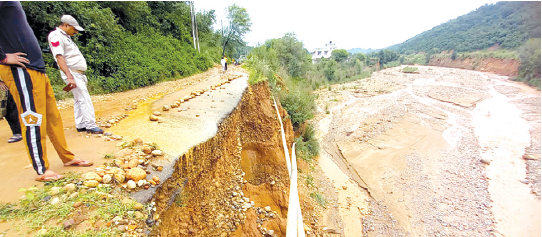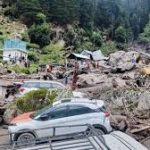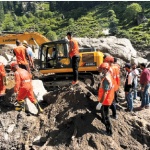Srinagar, Aug 18: Back-to-back extreme weather conditions have pushed Jammu division to the forefront of monsoon-related disasters this year, highlighting a grim pattern of vulnerability in the Chenab–Tawi belt.
On August 14, a devastating cloudburst at Chisoti along the Machail Mata Yatra route in Kishtwar flattened a pilgrim langar, a security post, and roadside shelters in minutes. Over 60 people were confirmed dead, 100+ injured, and dozens remain missing. Less than 72 hours later, another cloudburst in Kathua triggered twin landslides at Jodh Khad and Juthana, killing seven, including five children, and disrupting both road and rail traffic in the region.
These two recent tragedies have once again spotlighted the susceptibility of Jammu’s mountainous districts to intense, short-duration rainfalls, which often convert narrow valleys into high-energy debris traps.
Jammu vs Kashmir: A Division-Wise Pattern
Data accessed by Rising Kashmir reveals a clear division-wise disparity in monsoon-related casualties since 2014. Jammu division has witnessed at least four major fatal cloudburst or flash floods: Doda (2017), Kishtwar (2021), Kishtwar (2025) and Kathua (2025)
Combined, these disasters have claimed over 100 lives. In contrast, Kashmir division recorded only two fatal cloudburst incidents in the past decade, at Baltal (2015) and Amarnath Cave Sector (2022), resulting in 18 deaths. Though cloudbursts also struck parts of Ganderbal and Bandipora in August 2024, no fatalities were reported despite widespread damage to infrastructure.
The 2014 flood in the Jhelum basin remains the Valley’s most catastrophic natural disaster in recent memory, with 277 lives lost across J&K, most of them in Kashmir. However, that event was marked by sustained rainfall over days, unlike the short-burst cloudburst pattern now dominating Jammu’s recent disaster profile.
The Deadly Pattern in Jammu
The steep terrain, narrow valleys, and deeply incised river systems in Jammu division, especially in the Chenab and Tawi catchments, continue to amplify the effects of sudden rain bursts.
In Kishtwar, the August 14 cloudburst hit just before noon, when hundreds of yatris and locals were gathered for lunch. The sudden surge of water and debris swept away vehicles, destroyed shelters, and buried homes under mud. Army, NDRF, and Air Force personnel managed to pull out over 160 survivors within hours, but dozens remain untraced.
In Kathua, the August 17 cloudburst triggered landslides that not only claimed lives but also disrupted transportation corridors, forcing emergency services to clear highway and railway tracks under difficult conditions.
These recent disasters follow a grim timeline: Honzar, Dachhan (Kishtwar), July 28, 2021: 26 dead, 17 injured and in Doda on July 20, 2017, at least 6 dead, 11 injured.
Each incident underscores the same vulnerability include rapid, localised rain events unleashing massive energy in the form of floods, debris flows, and landslides in fragile terrain.
Valley Cloudbursts: Less Frequent, Less Fatal
Kashmir division, in comparison, has witnessed fewer and less deadly cloudburst tragedies: In Baltal, 2015, two minors killed and ShriAmarnathji cave, July 2022: 16 killed, 15,000 evacuated.
In August 2024, multiple cloudbursts hit areas in Kangan (Ganderbal) and Arin-Dardpora (Bandipora), damaging homes, bridges, and roads, including the Srinagar–Leh highway, but no confirmed deaths were reported.
While the 2014 flood remains Kashmir’s deadliest disaster, it differed significantly in scale and cause from the cloudburst-led tragedies now increasingly seen in Jammu.
While the 2014 flood remains Kashmir’s deadliest disaster, it differed significantly in scale and cause from the cloudburst-led tragedies now increasingly seen in Jammu.
Experts attribute the higher frequency and impact of such disasters in Jammu to orographic factors, steep, mountainous topography, which accelerates runoff and increases the destructive force of rainfall events. Additionally, unregulated development, deforestation, and lack of early warning infrastructure exacerbate the human toll.
Technical assessments have also indicated that Jammu’s terrain and climate make it more prone to short-duration, high-intensity events — a vulnerability likely to worsen with climate change.
• Doda, July 2017: Cloudburst and flash flood kills 6–8, injures 11.
• Honzar, Dachhan (Kishtwar), July 2021: Night cloudburst kills 26, injures 17.
• Kishtwar, Aug 14, 2025: Pilgrims’ pit stop flattened, 60+ dead, 100+ injured, dozens missing.
• Kathua, Aug 17, 2025: Twin landslides kill 7, including 5 children
Timeline of Kashmir Casualties
• Baltal, 2015: Cloudburst kills 2 minors.
• Amarnath Cave Sector, July 2022: Flooding kills 16, 15,000 pilgrims evacuated.
• Ganderbal & Bandipora, Aug 2024: Damage-only events, no fatalities, roads and orchards affected.








